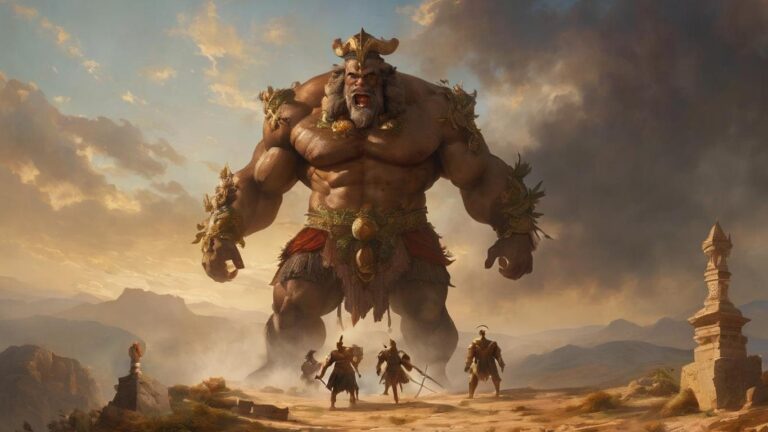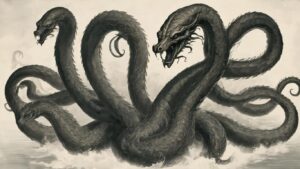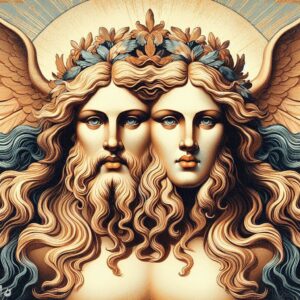Table of Contents
The rich tapestry of Greek mythology is adorned with a myriad of fascinating beings; moreover, among them stand the formidable Gigantes, or Giants. Born from the blood of Uranus, the Sky, during a tumultuous chapter in the cosmic narrative, these colossal and powerful creatures played a pivotal role in the mythical clash known as the Gigantomachy. As we delve into the depths of Greek mythology, the Gigantes emerge as enigmatic figures, embodying chaos and rebellion against the divine order.
The Origin
One significant battleground was Phlegra, a region synonymous with volcanic activity; it served as the backdrop for the Gigantomachy. Here, the Gigantes rebelled against the Olympian gods, engaging in a fierce clash that echoed the primal forces of creation.
In the aftermath of their defeat, Tartarus became a destination for some Gigantes. This abyss, nestled in the underworld, symbolized punishment for divine adversaries; thus, underscoring the formidable threat the Gigantes posed to the established order of the Olympian gods.
These mythic locations, Phlegra and Tartarus, resonate with symbolic significance. They reflect the eternal struggle between order and chaos in Greek mythology. The Gigantes, born of cosmic turmoil, left an indelible mark on the mythological landscape. Furthermore, their origins and battlegrounds weave a narrative tapestry that explores the enduring themes of power, rebellion, and the cosmic balance between opposing forces.
Appearance:
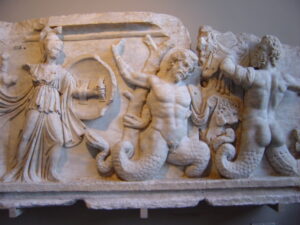
The Gigantes, colossal and monstrous, appeared with serpentine legs or multiple heads, inspiring fear and awe. Depicted as enormous creatures, their immense size and strength struck terror into those who beheld them. In ancient tales, the Gigantes’ formidable appearance symbolized the primal forces of chaos and rebellion against the divine order. Artists and storytellers crafted vivid images of these colossal beings, each portrayal capturing the essence of their mythical and fearsome presence. The intricate details of their monstrous form, whether serpentine legs or multiple heads, enhanced the mythical narrative, emphasizing the epic clash between the Gigantes and the Olympian gods.
Powers
The Gigantomachy
The Gigantomachy, a legendary battle, unfolded between the Gigantes and the Olympian gods. Symbolizing chaos and order, this epic conflict reverberated through the cosmos. Transitioning into the mythic battleground, the Gigantes clashed with the gods; simultaneously, each side vied for dominance. With thunderbolts and divine might, the Olympians, led by Zeus, confronted the formidable Gigantes. Their rebellion embodied a primal force challenging the established order. As the battle raged, Heracles joined the fray, aiding the gods and contributing to the Gigantes’ downfall. In the aftermath, the Gigantomachy left an indelible mark on Greek mythology, serving as a testament to the eternal struggle between chaos and divine authority.
Individual Gigantes
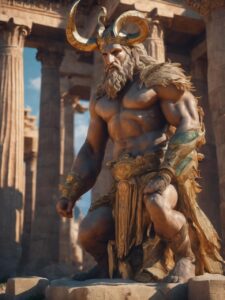
In the realm of Gigantes, Alcyoneus and Polybotes, distinct in abilities, carved their legends. Alcyoneus, gifted with regeneration near his homeland, provoked the wrath of Heracles. The hero, relentless and cunning, devised a plan. Transitioning to confrontation, Heracles led Alcyoneus far from his regenerative sanctuary. In the alien territory, Heracles struck, unrelenting and strategic. Alcyoneus, stripped of his unique advantage, succumbed to the hero’s might. As life ebbed, the once-invincible Gigante faced an ironic demise.
Shifting focus to Polybotes, a different saga unfolded. Seeking refuge in the sea, he eluded direct confrontation. Transitioning to the divine realm, Poseidon, angered by Polybotes’ audacity, devised a fitting end. From the island of Kos, a colossal fragment hurtled through the air. Polybotes, caught in the trajectory, met his cataclysmic fate. The sea, once a sanctuary, became his watery grave.
Reflecting on these tales, the Gigantes’ destinies unfolded in unique hues. Additionally, Alcyoneus, robbed of his homeland’s advantage, met his end through mortal cunning. Similarly, Polybotes, seeking refuge, confronted the divine fury of Poseidon. In each saga, transitioning from myth to reality, the Gigantes faced fateful encounters, their stories etched in the annals of ancient lore.
Symbolism and Legacy
Beyond their mythical battles, the Giants symbolize the eternal struggle between order and chaos. Furthermore, their origins from the blood of Uranus and their rebellion against the Olympians exemplify the primal forces that shape the cosmos. The Gigantes’ legacy endures, encapsulating the timeless themes of power, rebellion, and the triumph of divine order.
The Creatures, born from the cosmic struggles of the Greek pantheon, leave an indelible mark on the tapestry of mythology. Moreover, as symbols of chaos and rebellion, their stories continue to captivate and resonate, inviting us to explore the profound complexities of the ancient Greek worldview and the enduring themes embedded in their myths.
FAQ
How tall was Gigantes?
In Greek mythology, the Gigantes are often portrayed as colossal and powerful beings, but specific measurements of their height are not provided. The emphasis is more on their formidable and giant-like characteristics rather than precise dimensions.
What is meaning of Gigantes?
The term "Gigantes" refers to a group of giants in Greek mythology. These beings are associated with chaos, rebellion, and conflict against the Olympian gods.
what is Gigantomachy?
"Gigantomachy" is a term used to describe the mythological battle between the Gigantes (giants) and the Olympian gods in Greek mythology. This epic struggle represents the cosmic conflict between order (the gods) and chaos (the Gigantes).
